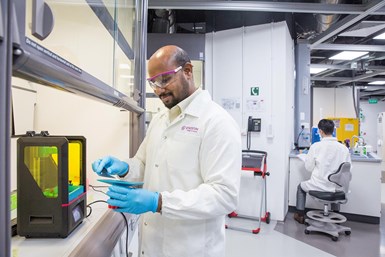Evonik Adds Three Infinam Photopolymers to Product Portfolio
Formnext 2022: These photoresin products are for use in common UV-curing 3D printing processes such as stereolithography (SLA) or Digital Light Processing (DLP).
Evonik is launching three new Infinam photopolymers for industrial 3D applications, expanding its photoresin product line for use in common UV-curing 3D printing processes such as stereolithography (SLA) or Digital Light Processing (DLP). With a total of seven new photopolymer formulations, Evonik is aiming to diversify the additive manufacturing (AM) material landscape.
Infinam RG 2000 L is a photoresin for the demanding eyewear industry. The company says the clear liquid formulation cures quickly and is easy to process. A low yellowing index — even after prolonged UV irradiation — not only make the high-performance material attractive for additively manufactured eyewear frames it is also suitable for applications such as microfluidic reactors or transparent high-end prototypes for observing the inner workings of complex assemblies. The light transmission of Infinam RG 2000 L also opens up further applications such as lenses, light guides and illumination covers.
Infinam RG 7100 L was specially developed for DLP printers and enables the production of parts with isotropic properties and low moisture absorption. The mechanical properties are comparable to those of an ABS material and the black-colored formulation can also be used on high-throughput printer systems. The printed parts exhibit fine features such as smooth and glossy surfaces making the photopolymer well suited for demanding design visualizations. Infinam RG 7100 L can also be used in applications such as drones, buckles or automotive parts that require high ductility combined with high impact strength. The printed parts can be machined and remain fracture-resistant even when subjected to high forces.
Infinam TI 5400 L offers a PVC-like resin for the rapidly growing market of limited edition designer toys. The white-colored material is well suited for objects with a high level of detail and excellent surface quality that are virtually indistinguishable from comparable injection-molded parts. The fully-cured material is said to combine excellent impact strength with high elongation at break and exhibits long-lasting thermomechanical performance.
“As one of Evonik’s six innovation growth fields, we are investing above average in the development of new formulations or the further development of existing products,” says Lutz Mindach, head of research development and innovation additive manufacturing at Evonik. “A broad material landscape is the basis for permanently establishing 3D printing as another large-scale industrial manufacturing technology.”
- Learn about Evonik’s first software tool for 3D printing, which was developed by Castor, an Israeli startup.
- Read about Evonik’s partnership with Evolve Additive Solutions to formulate thermoplastic materials for use in selective thermoplastic electrophotographic process (STEP) additive manufacturing solutions.
- Find out about Evonik’s implant-quality PEEK filament for 3D printing.
Related Content
-
NIOSH Publishes 3D Printing Safety Guide for Nonindustrial Settings
NIOSH has published a 3D printing safety guide for small businesses and other additive manufacturing users such as makerspace users, schools, libraries and small businesses.
-
Medical Molder Relies on 3D Printing to Speed Development of Inspection Fixtures
Medical molder Medbio uses FFF and SLA 3D printers in designing (and sometimes producing) its inspection fixtures.
-
Q&A With Align EVP: Why the Invisalign Manufacturer Acquired Cubicure, and the Future of Personalized Orthodontics
Align Technology produces nearly 1 million unique aligner parts per day. Its acquisition of technology supplier Cubicure in January supports demand for 3D printed tooling and direct printed orthodontic devices at mass scale.















